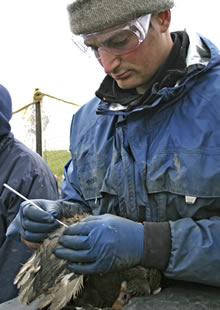
 |
 Potter Marsh Gallery |
June 18, 2008
Alaska pathway seems free of deadly bird fluAsian bird flu and its connection to Alaska was big news a few years ago, when dozens of Alaska scientists started checking birds migrating from Asia. So far, the news from the field is good. 
U.S. Geological Survey biologist Dan Rizzolo swabs an emperor goose to test for avian influenza on the Yukon Delta National Wildlife Refuge in 2006. Alaska scientists have performed this action on multiple thousands of birds migrating through Alaska. Photo by Donna Dewhurst. "There are strains of avian flu here, but not of the deadly stuff
The U.S. government spent millions in the last few years to enable
biologists to capture migratory birds and swab their rear ends to search for
signs of a deadly virus first found in Hong Kong in 1997. Since 2003, the
Asian H5N1 virus has spread west across Asia to Europe and Africa, and has
killed more than 240 people.
Alaska, so far, is clean.
"All agencies collectively sampled over 20,000 wild birds in Alaska, and the
bottom line is that in 2006, we found garden-variety avian flu in 1.7
percent of those birds, and we didn't find any of the Asian H5N1," said Tom
Rothe, the statewide waterfowl coordinator for the Alaska Department of Fish
and Game. "In 2007, we sampled over 12,000 birds and 0.7 percent had common,
low-pathogen influenza. Nationwide, over 100,000 birds were sampled (in 2006
and 2007) and nobody found any Asian H5N1."
In 2008, Alaska researchers will again test about 12,000 birds, most of them
waterfowl that can pick up flu viruses by ingesting water fouled with the
feces or other bodily fluids of birds.
Jon Runstadler, a veterinarian and an assistant professor at UAF, is part of
a team that has sampled 4,000 birds in Alaska since 2005 and 4,000 in the
Russian Far East, Japan, and Mongolia since 2006.
"We found a lot of viruses, mostly in waterfowl, and most of those have come
out of ducks in Minto Flats, which seems to be a relative hotspot for
influenza," he said. "But we've not found any viruses that are highly
pathogenic, and no H5N1."
This year, Runstadler and his colleagues are sampling birds at Minto Flats
all summer, rather than just convenient periods to catch birds, such as when
they are molting and lose their flight feathers.
"It's fading away in the media," Runstadler said of the hubbub over the H5N1
virus, but "most people studying influenza feel like there will be a
pandemic, or a pandemic-like situation, at some point due to the fact that
it's a virus that does unique things in the way it evolves and exists in the
natural world."
The 1918 influenza virus that killed 50 million people
"While H5N1 is currently the most likely candidate because it's out there
causing problems and moving around, we don't really know whether H5N1 is
going to cause a problem, or whether (a similar type of virus will cause a
problem)," Runstadler said.
Why haven't Alaska scientists been finding infected birds here? The Pacific
Ocean and Bering Sea might be acting as barriers to the deadly strain of flu
that might be present in birds while they winter in Vietnam, Thailand, or
Indonesia.
"Maybe they can't carry (the virus) that long," Rothe said. "Maybe they die
before they get here, or the virus runs its course."
Whatever the reason the deadly virus isn't showing up here, scientists will
keep checking birds as long as the funding arrives to do so.
"If Congress thinks it's still an important enough project, we'll keep
testing birds," Rothe said.
© AlaskaReport News |
|